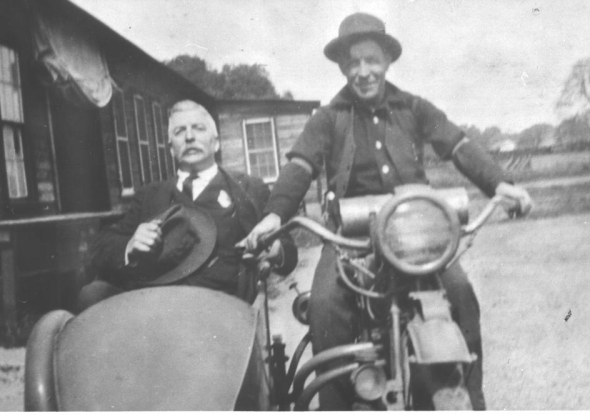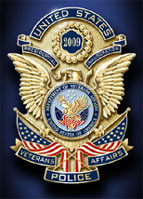Origins of VA Police Force – National Police Week
Posted: May 15, 2015 Filed under: Appreciation, History, Service, Veterans Leave a commentIn Honor of National Police Week

The roots of VA’s police force began nearly 150 years ago at the National Home for Disabled Volunteer Soldiers (VHA origins). In September 1867 a court-martial system was established at the National Homes to consider all types of offenses made by veterans who lived at the Home. Judgment and sentencing were determined by the Governor of each National Home and a Sergeant of Police, who was a member of the Home, was appointed and paid $15 per month. By comparison, the Home’s chief baker was paid $20 monthly and nurses (male in those days) earned $8 a month. A guard house (jail) was located on National Home grounds to protect the Home’s resident’s from themselves or others.
The first official police force was authorized at the National Home’s Central Branch in Dayton, Ohio, on April 11, 1882. The police force consisted of a Captain, one 1st Lieutenant, and one 2nd Lieutenant who were charged with preserving “the peace and quiet of the branch.” They were referred to as “guards” and the police force eventually expanded to include more than 40 guards. The National Homes operated under military rules, which often did not suit many of the former yeomen and young immigrant residents who lived there. Drunkenness, fighting, going AWOL (without a pass), cursing, disorderly conduct, and creating a nuisance were the most common offenses at the National Homes. Court was held at least once a week with punishments issued by the Home’s governor and recorded in “Discipline Books.”
The Guard House at the National Home’s Mountain Branch, now Mountain Home VAMC, in Johnson City, TN, 1910 c.
Guards at National Home’s Danville Branch, now Danville (IN) VAMC, 1898

Left image is from the Discipline Book of the National Home’s Northwestern Branch, now Clement J. Zablocki VAMC, in Milwaukee, 1898 c.
The most serious offense at the National Homes was bringing liquor onto the grounds and “jumping the fence” (defiantly leaving the grounds without a pass). The majority of offenses were caused by the abuse of liquor. In 1888 the branch at Dayton recorded 3,446 discipline charges of which 1,192 were for drunkenness and 1,138 for going AWOL. Members of the National Home who misbehaved while AWOL or on approved leave were beyond protection of the National Home and subject to civilian law, arrest, and detainment in local jails.
Punishment for minor offenses at the National Homes included monetary fines or no passes for 30 days. For more serious crimes, veterans were often assigned to “dump duty.” In the 19th century, “dump duty” meant emptying and cleaning cuspidors, bedpans, and picking up trash from the grounds. The most severe punishment was stone breaking. Stone breaking began at 7 o’clock in the morning. The guilty man was escorted from the guard house to his work pile and back until his sentence was completed. He was allowed one hour and 20 minutes for lunch and his day ended at 5:40 p.m. A stone breaking sentence could last for up to six months. Habitual serious offenders were labeled as “incorrigibles” and were dishonorably discharged from the Home.

The National Homes became part of the Veterans Administration in 1930 and the Home police forces were retained; however, their adjudication system and guardhouses were abandoned. Having no official police power at the time, guards checked entrants into VA properties, ensured the safety of everyone on grounds, and handed criminal offenders over to state or local police officers for processing in civilian courts or to the Department of Investigation (FBI’s predecessor before 1936) for federal crimes. Police staff at Veterans Bureau hospitals were also integrated into VA during the 1930 merger. The Veterans Administration police operated in this manner for over 40 years. (photo, left – Police officer at Menlo Park, 1920s)
After 1970, the number of violent crimes on VA grounds increased and change became imminent. Guards were elevated to full police status and their training and responsibilities increased. VA police were provided one weapon: mace. Afterwards, police batons were added and a VA Police training center was established in North Little Rock, Arkansas, to ensure standardized training throughout the VA system. During the 1980s, a number of incidents took the lives of four unarmed VA police officers and several other VA personnel, which precipitated more changes.
In 1989, after the Veterans Administration became the Department of Veterans Affairs, VA’s Police and Security Service was reorganized as the Office of Security and Law Enforcement. Training for VA police increased from 40 hours in the 1970s to 160 hours by 1992. In 1992, VA considered arming its police force for the first time.

In 1995, under Secretary Jesse Brown, a pilot project to arm VA police at no more than six facilities began. The following year, a directive and handbook were written. The FBI Academy’s Firearm Training Unit reviewed VA’s firearm training plans and determined that it met or exceeded Federal law enforcement requirements. In September 1996, North Chicago VA Medical Center became the first facility to arm its police officers, followed by Richmond, Bronx, West Los Angeles, and Chicago (West Side). The pilot project proved successful, so around 1998, Secretary Togo West expanded the arming of VA police at a rate of roughly 16 sites per year.
Following the terrorist attacks of September 11, 2001, VA’s arming program was accelerated. VA contracted with Beretta USA for specially designed pistols and firearms training for its police force. By the fall of 2002, 92 VA hospitals had 1,830 armed police officers and by 2003 the entire force was armed. In April 2002, Jose Rodriguez-Reyes, an officer at the San Juan VAMC in Puerto Rico, was the first VA officer killed after the police force became armed. Since 1985, at least seven VA police officers have lost their lives while on duty.
Today VA’s police officers face innumerable challenges in comparison to the guard force of the past. Their duties include conducting investigations related to accidents or crimes, surveillance, fraud detection, preventing or defusing violence in the workplace, fingerprinting and much more. VA police officers work with the Federal Bureau of Investigation and Department of Homeland Security to ensure enforcement of all federal laws and safety of veterans, employees, contractors, visitors, and the public. Not only are they on the alert for domestic and workplace violations, they watch for terrorist activity and respond in emergencies of all kinds, as well. Many of VA’s police force work behind the scenes as trainers, investigators, analysts, policymakers, developers of standards and practices, and other positions, carrying on a tradition and work ethic that spans more than 100 years. Today we honor those VA police officers who paid the ultimate price for protecting us.
Historian, Veteran’s Adminisration



